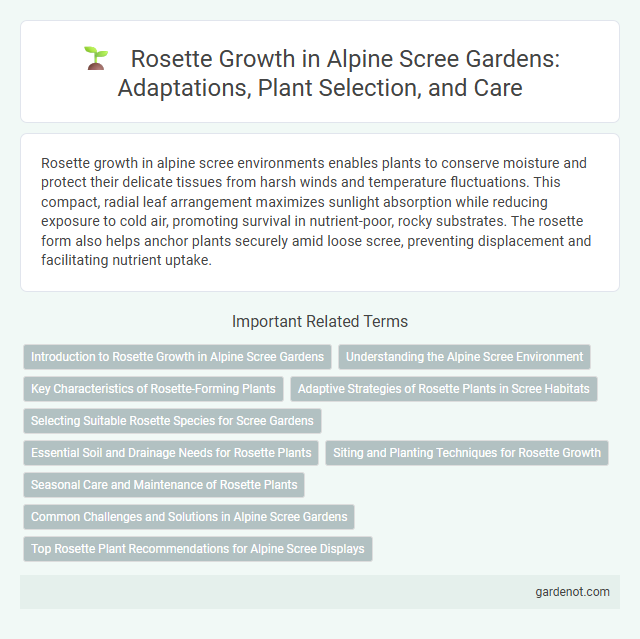Rosette growth in alpine scree environments enables plants to conserve moisture and protect their delicate tissues from harsh winds and temperature fluctuations. This compact, radial leaf arrangement maximizes sunlight absorption while reducing exposure to cold air, promoting survival in nutrient-poor, rocky substrates. The rosette form also helps anchor plants securely amid loose scree, preventing displacement and facilitating nutrient uptake.
Introduction to Rosette Growth in Alpine Scree Gardens
Rosette growth in alpine scree gardens refers to the compact, circular arrangement of leaves close to the ground, allowing plants to conserve moisture and resist harsh winds. This growth form is crucial for survival in the nutrient-poor, well-drained soils characteristic of scree environments. Common alpine species exhibiting rosette growth include Saxifraga and Androsace, which optimize sunlight absorption and reduce water loss through their dense foliage.
Understanding the Alpine Scree Environment
Rosette growth in Alpine scree is highly adapted to the harsh, unstable substrate consisting of loose rock fragments and minimal soil. Plants develop compact, low-lying rosette formations to conserve moisture, resist wind exposure, and maximize nutrient absorption in nutrient-poor conditions. Understanding the physical and chemical properties of Alpine scree, such as temperature fluctuations and erosion patterns, is essential to explaining rosette morphology and survival strategies.
Key Characteristics of Rosette-Forming Plants
Rosette-forming plants in alpine scree exhibit compact, low-growing structures that minimize exposure to harsh winds and temperature fluctuations. Their densely packed leaves maximize water retention and protect meristematic tissues from frost damage. These adaptations enable survival in nutrient-poor, well-drained scree environments by conserving resources and enhancing photosynthetic efficiency.
Adaptive Strategies of Rosette Plants in Scree Habitats
Rosette plants in alpine scree habitats exhibit adaptive strategies such as compact, low-lying leaf arrangements that minimize water loss and protect meristematic tissues from cold and wind abrasion. Their dense leaf rosettes enhance heat retention and reduce soil erosion around the root zone, facilitating nutrient uptake in unstable, rocky substrates. These adaptations enable rosette plants to survive harsh alpine conditions characterized by intense UV radiation, temperature fluctuations, and limited soil moisture.
Selecting Suitable Rosette Species for Scree Gardens
Selecting suitable rosette species for alpine scree gardens involves prioritizing plants with strong drought tolerance and shallow root systems adapted to rocky substrates. Species such as Sempervivum, Saxifraga, and Jovibarba thrive in well-drained, mineral-rich soils, showcasing compact rosette growth that minimizes moisture loss and withstands temperature fluctuations. Incorporating these resilient rosette plants enhances garden stability while maintaining the natural rugged aesthetic characteristic of alpine scree environments.
Essential Soil and Drainage Needs for Rosette Plants
Rosette plants thriving in alpine scree require well-drained, nutrient-poor soils that mimic their natural rocky habitat. Essential soil conditions include loose, sandy or gravelly substrates that prevent water retention and root rot. Proper drainage is critical, allowing excess moisture to flow freely and supporting healthy rosette growth in challenging alpine environments.
Siting and Planting Techniques for Rosette Growth
Plant Rosette species in well-drained, rocky substrates with ample sunlight to mimic their natural alpine scree habitat. Utilize soil mixtures rich in coarse sand and organic matter to ensure adequate aeration and moisture retention without waterlogging. Space plants to allow airflow and reduce competition, promoting robust Rosette growth in challenging mountain environments.
Seasonal Care and Maintenance of Rosette Plants
Rosette plants in alpine scree require careful seasonal maintenance to thrive in harsh conditions. During spring and summer, ensure well-drained soil and moderate watering to prevent root rot, while protecting the plants from intense midday sun with temporary shading. In autumn and winter, reduce watering significantly and remove dead foliage to avoid fungal infections and prepare the rosettes for dormancy.
Common Challenges and Solutions in Alpine Scree Gardens
Rosette growth in alpine scree gardens often faces challenges such as poor soil drainage, extreme temperature fluctuations, and limited nutrient availability. These plants require well-drained, gritty substrates to prevent root rot and benefit from microclimate management techniques like using rock placement to buffer temperature extremes. Regular soil enrichment with organic matter and careful monitoring of moisture levels can optimize rosette health and ensure successful growth in harsh scree environments.
Top Rosette Plant Recommendations for Alpine Scree Displays
Top rosette plants for alpine scree displays include Sempervivum, Saxifraga, and Androsace species, known for their adaptability to rocky, well-drained soils and extreme elevation conditions. These plants exhibit compact growth forms with succulent leaves that conserve moisture and withstand cold temperatures, ensuring vibrant ground cover. Incorporating diverse rosette species enhances visual interest and ecological resilience in alpine scree gardens.
Rosette growth Infographic

 gardenot.com
gardenot.com